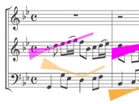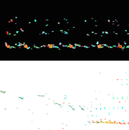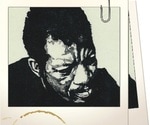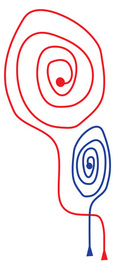|
James, S., Hope, C., Vickery, L., Wyatt, A., Carey, B., Fu, X. and Hajdu, G. (2017). Establishing connectivity between the existing networked music notation packages Quintet.net, Decibel ScorePlayer and MaxScore. Tenor 2017 Conference, University of A Coruña.

In this paper we outline a collaboration where live internet-based and local collaboration be- tween research groups/musicians from Decibel New Music Ensemble1 (Perth, Australia) and ZM4 (Hamburg, Germany)2, was facilitated by novel innovations in customised software solu- tions employed by both groups. The exchange was funded by the Deutscher Akademischer Austauschdienst and Universities Australia. Both groups were previously engaged in the research and performance of similar musical repertoire such as John Cage’s ‘Five’ (1988) and ‘Variations I-VIII’ (1958-67) among others, the performances of which utilise graphic, animated and extended traditional Western music notation. Preliminary steps were taken to achieve communication between the three exist- ing network music notation packages, the Decibel ScorePlayer, MaxScore and Quintet.net, facilitating a merging – and ultimately an extension – of notational approaches previously pre- scribed by each music notation package. In addition to the technical innovations required to achieve such a project, we consider the out- comes and future directions of the project, as well as their relevance for the wider contemporary music community.
|
Vickery, L. (2017). Visualising the Sonic Environment. Australasian Computer Music Conference 2017, Adelaide.

Emulation of the sounds of the natural environment may be one of the earliest
manifestations of music. Alvin Lucier’s (Hartford) Memory Space (1970) and Carbon Copies (1989) both explore this impulse, instructing performers to imitate the sounds of any indoor or outdoor environment (albeit pre-recorded), “as exactly as possible, without embellishment” (Lucier, A. 1989. Carbon Copies. Material Press: Frankfurt am Main). This final clause may have been necessary because the complexity of natural sonic environments often prohibits exact imitation and encourages embellishment. This paper describes a scoreplayer implemented in MaxMSP, that analyses and visualises significant features of a sonic environment as a graphic score, that is scrolled from right to left across the computer screen. Playback of the source recording is delayed so that it is heard as the corresponding visual event arrives at the “playhead”: a black line of the left of the screen. The frequency of principal features of the recorded environment are represented every 10ms by the placement of rectangles in vertical space, amplitude by the size of the rectangle, and the brightness, noisiness and bark scale value of each event as the luminance, hue and saturation of each rectangle. The final three parameters provide an indication of timbral changes in the source recording. While not strictly “real-time” (recorded sounds are delayed by 12 seconds), this environmental sound scoreplayer allows performer(s) to engage with natural sonic environments in a site-specific manner, using field recordings and sonorous objects from the vicinity of a performance. It provides a mechanism for the performance of, or improvisation around, significant sonic features from the natural environment.
|
Vickery, L. and James, S. (2017). The Enduring Temporal Mystery of Ornette Coleman's Lonely Woman. Music Performance and Analysis: Proceedings of the WA Chapter MSA Symposium, University of Western Australia, Perth.

Lonely Woman from Ornette Coleman’s groundbreaking 1959 album The Shape of Jazz to Come brought a completely fresh form of musical texture to Jazz. The texture in which a fast-paced, but unmetered rhythm section sits under, and in stark contrast, to a slow moving and highly rubato hymn-like melody has led to descriptions of the music being “completely free of meter”, “rhythmically elastic“ or “freely pulsating time”. In Coleman’s musical output Lonely Woman became the template for a set of works, such as Broken Shadows (1971) and What Reason Could I Give? (1971), that Peter Wilson has categorized as the “Coleman Ballad” group. There have been numerous transcriptions of the work, however representing the complexities of the unusual two stream nature of the rhythmic and melodic material, is always avoided in favour of “an approximation of reality” (often in 4/4).
This discussion seeks to precisely unravel the relationship between the rhythm section and the melodic instruments in Lonely Woman using digital analysis tools. It aims to uncover the role of synchrony and asynchrony in forming what has been properly described as a “unified performing aesthetic” of “seemingly opposing musical elements in juxtaposition against one another.”
| ||||||||||||||||||



